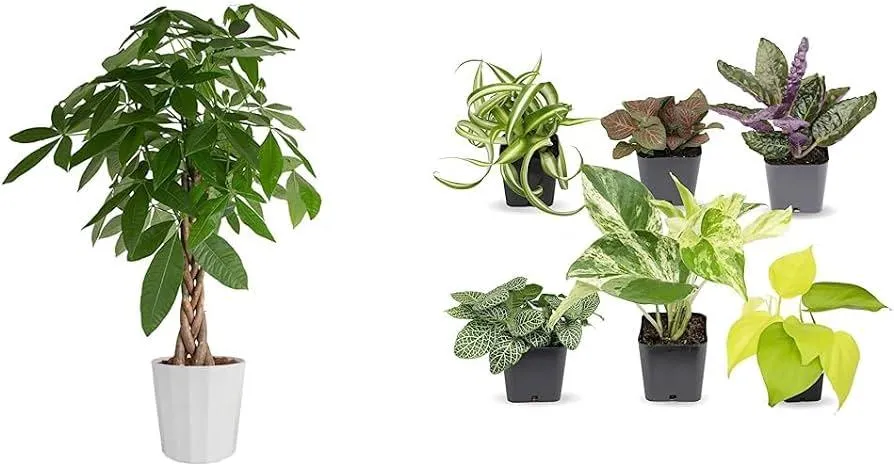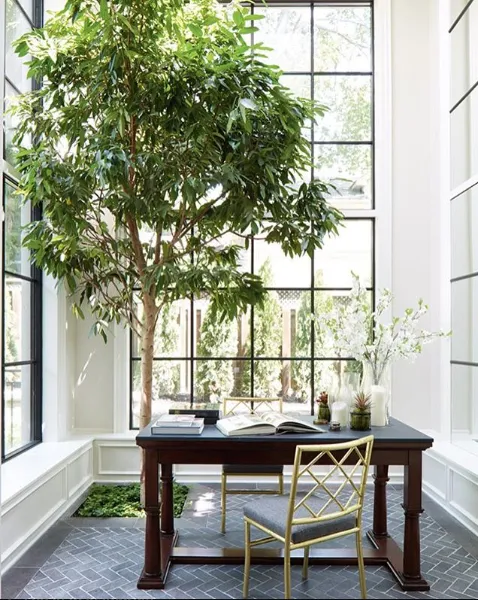The Ultimate Guide to Growing Indoor Plant Trees
Whether you’re looking for a bit of greenery to brighten up your home or want the calming influence of nature inside, indoor plant trees can be a great addition. But with so many varieties to choose from, it can feel overwhelming to decide what type is best for your space and care needs. In this article, I’ll break down everything you need to know to pick and care for the perfect indoor tree for your home.
Choosing the Right Type of Indoor Tree
The first step is selecting a variety suited to life indoors. Here are some of the top options to consider:
- Money trees (Pachira aquatica): Known for their braided trunks and epiphytic roots, money trees are super easy to care for and thrive in low to medium light. They’re basically bulletproof!
- Dracaena: These tall, slender trees come in a variety of colors from green to red to yellow striped varieties. Dracaenas tolerate low light well and don’t mind the occasional dry spell.
- Chinese evergreen (Aglaonema): With their heart-shaped leaves in shades of green, pink, or white, Chinese evergreens make a beautiful accent. They’re quite happy with medium light and occasional watering.
- Rubber tree (Ficus elastica): With their glossy foliage ranging from green to burgundy, rubber trees have a more dramatic presence. They prefer bright, indirect light and moderate watering.
The type you choose will depend on your home’s light conditions and the vibe you’re going for. But all these varieties are tough customers that can forgive the occasional forgotten watering.
Picking the Perfect Pot
A good container is crucial for your indoor tree’s long term health and appearance. Choose a pot just 1-2 inches wider than the root ball for optimal growth. Glazed ceramic or terracotta work well for drainage. And if kitting out a big rubber tree, look for something over 10 inches wide to accommodate those beefy roots.
From my experience, it’s kind of a drag lugging home an unwieldy rubber tree in a huge pot, so I often start plants in slightly smaller pots and gradually upsize to avoid killer workouts! Make sure there are holes in the bottom for drainage to keep your tree’s feet dry.
Nailing the Optimal Growing Conditions
Indoor trees have adapted to tolerate less-than-ideal situations we subject them to in our homes. But providing ideal growing conditions will help your tree thrive rather than just survive.

Light is crucial – position your tree in a spot getting medium to bright, indirect sunlight for at least 6 hours daily. Direct sun rays through south-facing windows can scorch leaves, so kinda be careful with that. Most varieties do best between 60-80°F.
Moisture needs vary by species. Rubber trees like to dry out slightly between waterings, while money trees love to stay constantly damp. Stick your finger an inch into the soil and water thoroughly when the top layer feels dry. Under-watering is safer than overdoing it and getting root rot.
Basic Care and Maintenance
To keep your indoor tree looking its best with minimal effort, follow these simple tips:
- Dust leaves periodically with a dry microfiber cloth to keep them photosynthesizing at peak capacity
- Check drainage holes to ensure they stay clear and water can escape the pot
- Repot every couple years in early spring when the tree outgrows its container
- Fertilize in growth season every few months for lush foliage using a diluted, all-purpose liquid plant food
- Prune gangly branches or styling the tree’s shape as needed
Proper care is easy peasy once you get the hang of your tree’s needs. I’ve legit kept the same money tree for like 5 years with minimal fuss, it’s kind of incredible how low maint they are!
Common Pests and Problems
The main issues indoor trees face are usually due to environmental factors like too much or too little water, light, heat or humidity. But a few pests sometimes cause trouble:
Spider mites: Tiny pests that congregate on undersides of leaves and suck out plant juices, leaving stippling. Control with horticultural oil spray.

Scale: Hard, dome-shaped insects that cling to branches. Wipe off with cotton cloth dipped in rubbing alcohol.
Mealybugs: Fluffy white masses in leaf joints or bark crevices. Dab with cotton soaked in rubbing alcohol.
Prevent problems by choosing a healthy plant, providing optimal care, and keeping an eye out for early signs. With quick treatment, pests are usually no biggie!
Getting Creative with Indoor Tree Placement
Once you’ve selected your tree and have it thriving, play around with stylish placements throughout your home. Here are some ideas:
- Place a tall ficus or dracaena in a corner for an effortlessly chic accent
- cluster matching trees in modern ceramic pots on floating shelves
- add visual interest by placing trees of varying heights on credenzas or side tables
- show off braided trunk styles on entryway console tables or mantels
You could also try unconventional spots like bathrooms for that jungle-shower vibe or next to a south-facing kitchen window to brighten meal prep. The possibilities are endless – get creative!
Tending an Indoor Tree Is Totally Worth It
While indoor trees may require slightly more TLC than sturdy pothos or succulents, their elegant forms and lush greenery make them a top choice for elevating your home’s aesthetic. Plus their ability to help purify air and reduce stress has benefits that extend beyond looks.

When chosen and cared for properly, trees can thrive indoors for years, becoming cherished companions that tie together a space. So don’t be afraid to bring the outside in! With some patience at the start, a beautiful indoor tree forest can be totally within reach.
I hope this guide has helped shed light on all your indoor tree questions and intentions. Feel free to let me know if you need any other tips for care or styling ideas. May your new leafy friend bring you plenty of zen vibes!
Factors to Consider When Choosing an Indoor Houseplant
| Plant | Sunlight Needs | Watering Needs | Height | Care Level |
|---|---|---|---|---|
| Chinese Evergreen | Low | Allow soil to dry out between waterings | 2-5 feet | Easy |
| Pothos | Low to Medium | Allow soil to dry out slightly between waterings | Trailing vines up to 10 feet | Very Easy |
| Spider Plant | Medium | Allow soil to dry out slightly between waterings | 2-3 feet tall with spreading runners | Very Easy |
| Snake Plant | Low | Allow soil to dry out completely between waterings | 2-4 feet | Very Easy |
| Zanzibar Gem | Medium to High | Allow top inch of soil to dry out between waterings | 2-3 feet | Easy |
FAQ
-
What kind of trees can be grown indoors as houseplants?
Some common indoor tree options are:
- Fig trees
- Citrus trees like oranges and lemons
- Dieffenbachia (also called dumb cane)
- Dracaena
- Pothos
-
How much sunlight do indoor trees need?
Most indoor tree species require medium to bright light. Direct sun for a few hours each day is sort of ideal. A south or west facing window generally provides sufficient light. However, some types like fiddle leaf figs can cope with less sunlight.
-
What kind of soil do indoor trees prefer?
Trees grown indoors basically need a soil mixture that drains well while retaining moisture. A standard potting mix for houseplants typically works fine. You can mix in some perlite or vermiculite to improve drainage if needed. The soil shouldn’t stay soggy.
-
How often should indoor trees be watered?
Watering frequency depends on the tree type and growing conditions. As a general guideline, check the soil moisture every 5-7 days. Water thoroughly when the top inch becomes dry. Cut back watering in winter when light levels are reduced. Do indoor trees drown easily if overwatered? Perhaps go by the “waterlogged” test rather than a strict schedule.

-
How can indoor trees be fertilized?
Apply a diluted liquid houseplant fertilizer monthly in the spring and summer. Read the label for mixing instructions. In fall and winter, fertilize every 6-8 weeks. On the other hand, some experts recommend fertlizing indoor trees only a few times a year, if that. Go light as it’s easy to over-give fertilizer in limited indoor pots.
-
What sorts of pests and diseases affect indoor trees?
Common pests include aphids, spider mites, and scale insects. Root and leaf diseases can strike if conditions are less than ideal. Providing good care and checking regularly for signs of issues will help indoor trees avoid pests and issues, or at least catch stuff early before it gets out of hand. Perhaps shower the trunk and top of the soil monthly as a preventative measure.
-
How large do different indoor tree varieties grow?
Size ranges greatly – from a few feet to over 10 feet tall. Dwarf varieties and careful pruning keep most suitable as houseplants. Do your research beforehand though – some “indoor trees” can get enormous! Measure available space and check mature dimensions when selecting a variety. With limited indoor space, maybe better to choose shrubs or large bushes over garden-size trees for your home.
